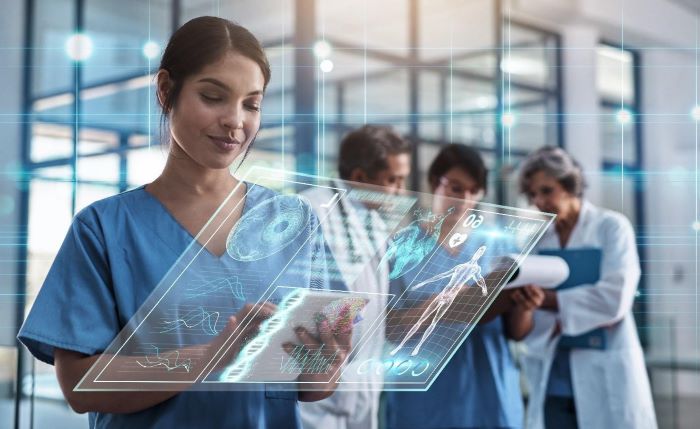Technology has advanced just about every industry in the last 50 years, and healthcare certainly hasn’t been left behind. In just about every area, from diagnosis and direct patient care to medications and medical equipment, leaps in technology have allowed for an evolution in healthcare. Many diseases that were thought untreatable a few decades ago are now routinely dealt with. Many have been eliminated, and on the rare occasion that they do occur, they are treated with common medications.
Today’s doctors and nurses have equipment that makes their work much easier. They can diagnose illnesses faster; their diagnoses are more accurate; and they can start treatment as soon as they can figure out what is ailing a patient. Creating treatment plans and delivering medications have also been made easier, which has had an overall positive impact on patient care.
For those contemplating a career in healthcare, the future is rosy – there is no indication that the rate of technological advancement will slow down. As technology advances, the healthcare sector will advance with it. This will open doors to numerous pathways for those looking to embark on a healthcare career.
Does new technology attract professionals to healthcare?
Technological advancements have made the healthcare sector more attractive to professionals. Today, busy doctors can see more patients thanks to advancements such as telehealth and online forms. Doctors and patients just need an internet connection, and then they can discuss symptoms. A diagnosis can be made, and a prescription can be issued online at the same time.
For nurses, routine tasks were done by hand, and they could only help a limited number of patients during each shift. Today’s technological advancements allow nurses to do much more for their patients, and new equipment means that there are fewer manual tasks.
It isn’t difficult to find a route into the healthcare profession. As long as you have a high school diploma and have done well in the sciences, it is possible to embark upon a healthcare career. It is relatively easy to qualify to become a registered nurse (RN), for example. However, those who want to specialize can enroll in MSN online programs like the one at Wilkes University. The course covers advanced nursing, advanced role development in nursing, health policy and politics for advancing nursing practice, and diagnostic reasoning for nurse practitioners, and incorporates the latest advancements in technology.
Students can complete the course in as little as two years, and by that time, they will have specialized in one of three areas: psychiatry and mental health, family nursing, or adult-gerontology primary care. Upon graduation, they are fully qualified nurse practitioners who can assume leadership roles within healthcare organizations, understand the relationship between theory and practice, conduct research, present their results, and deliver evidence-based care.
For those who are keen on joining the profession, it is worthwhile to explore how technology will impact your job once you are employed. What difference will it make in day-to-day interactions with patients?
How have advancements in technology impacted healthcare?
We are living in a world where a patient can access healthcare at any time, wherever they are located. They can monitor their basic health, receive a remote diagnosis and personalized care, and therefore live for much longer than they would have in the past, all thanks to advancements in healthcare.
In the below sections, we will look at the technological advancements that are most commonly found in medical institutions in America today.
Telehealth
This is perhaps the most impactful development in healthcare in recent years. Telehealth is not a new concept – it has been with us since the early 20th century. It was used to advise clinics on ships, and in far-away locations, medics consulted doctors through radio to deliver treatment to people in remote villages. Today’s telehealth is very different. Patients from anywhere in the world – if they have an internet connection or a telephone – can consult doctors and nurses.
Not only has technology proved critical in saving lives, but it has also lowered the cost of healthcare delivery for both the institution and the patient.
The COVID-19 pandemic played a significant role in propelling telemedicine to the forefront of healthcare. Because of the restrictions that were placed on people’s movement all around the world, the only way that many of us could access medical care was by video calling our healthcare providers. In no time at all, we saw the development of apps, phonelines and various other methods that made communication easier.
Today, this technology is becoming part of mainstream medicine and has been adopted across America. In rural areas, it is especially useful, allowing for easier access to medical care. Where patients had to travel many miles to see a doctor or a nurse, they now only need to log into a video chat, describe their symptoms, and get a diagnosis and a prescription.
Medics can use it to transmit imaging results, test results and other critical medical information to their patients. It is also a useful tool for consultation, and patients don’t have to wait for hours to get answers.
Wearable devices
This technology is also used to monitor patients, especially those suffering from chronic illnesses. As long as the patient has the right hardware (mobile phone or computer, medical alert bracelet or watch) and the right software, they can monitor vital signals, which are also transmitted in real time to the healthcare provider. If there are anomalies, then the provider can take immediate steps to help the patient, either by organizing for them to come into the hospital or advising them on what to do.
Electronic health records
Imagine trying to retrieve medical information in the 1970s or 1980s. It required looking through thousands of paper files for information, and the older the information was, the more files had to be looked through. Electronic health records have changed all this, and whether you’re looking for information that is a few months or years old, all it takes is a patient’s name or unique number.
Electronic health records have allowed for faster access to information, which means that patients don’t have to be kept waiting and treatments can be delivered much faster. In many states, hospitals have connected networks, so it doesn’t matter where the patient receives treatment – their medical files can be easily accessed within moments, wherever they are located.
This form of recordkeeping has reduced patient care errors because healthcare providers can see the full medical history of any patient they are treating. In the rare event that errors occur, it is easier to trace their source because all the information is searchable.
Simulation training
This is a process that allows healthcare professionals to have an artificial representation of real-world processes. One of the earliest examples of simulation training is CPR, where students are required to practice life-saving procedures on dummies until they perfect their skills.
Today, simulation training has come a long way from practicing CPR on dummies. The use of virtual reality (VR) allows medics to do so much more than they could in the past. They can immerse themselves in real-life situations to deliver life-saving care, exploring all the different possibilities for delivering timely and effective treatments.
A good example of this is when nurses must practice how to intubate a patient. In the past, they learned from watching older, more experienced nurses carry out the procedure. Today, with a VR program, they can practice intubation on a virtual patient and perfect their skills.
Simulation training allows doctors and nurses to immerse themselves in difficult conditions and assess their readiness. A surgeon who is facing a complicated surgery, for example, can use a VR training module to conduct a similar virtual surgery before they operate on the real patient. Not only will they see exactly what the procedure entails, but they will also learn what challenges they can expect during the procedure.
Mobile health
Mobile health is making a significant difference in rural America and in communities that cannot afford conventional healthcare. With this technology, rather than patients going to see doctors and nurses in hospitals, the medics come to them.
They have vehicles that are fully equipped to deliver basic healthcare and can move from one location to another to attend to patients, all while uploading patient information to a central database back at the hospital.
It makes for healthier communities, and many people who have little or no access to healthcare – particularly those in rural locations – can now rely on their mobile healthcare provider to do the necessary tests and diagnosis and provide treatment.
This type of healthcare delivery is making a huge difference for the elderly of America, many of whom have difficulty getting to healthcare facilities. The mobile doctor and nurse visits their neighborhoods and all they must do is keep track of the days when the medics are available.
Big data
Big data is large amounts of information that would be difficult to process without automation. Technological advances have made big data easy to manipulate, and it can be used to draw conclusions that save millions of lives.
During the COVID-19 pandemic, for example, we saw maps of how the virus was spreading across the world. Researchers and medics were able to use big data to bring us information that would have been impossible to deliver so promptly in the past.
Big data is not only useful for tracing the spread of pandemics, but is also used to map out chronic illnesses and their causes – and it also provides insights into what can be done to improve community health.
Patient-centered care
Patient-centered care has been adopted in healthcare facilities across America. This means that rather than the doctor and nurse making decisions on behalf of the patient, they include them throughout the process and listen to their wishes when it comes to how they would like to be treated and cared for.
This is especially important for those suffering from chronic illnesses because they receive long-term treatment. It is also useful for those who have come to the end of their lives. They can tell the healthcare team about how they would like to be cared for in their last days.
Patient-centered care also requires involving the family in medical decisions about their loved ones. They can tell the doctors and nurses how they would like their relative or friend to be cared for, and their opinions are considered when a treatment plan is created.
Health apps
Health apps have become commonplace. Many people can now track their vital health using health apps, set up goals they wish to achieve, and monitor how their body changes over time.
With a simple digital watch and a phone app, anyone can monitor vital signs such as blood pressure, heartbeat and even oxygen levels in the blood.
Health apps allow for early intervention in the event of problems. If someone notices a consistently high blood pressure reading, for example, they can go into the hospital for further tests, and early treatment will help them avoid complications in the future.
Some apps are free, and some are paid for, but users should check what features are available before they choose an application to monitor their health.
Looking to the future
Technology is moving at an unprecedented rate, and it is expected to continue to improve healthcare delivery. Those who enter the profession now can expect to have many tools and devices that make it easier to treat and care for patients.





